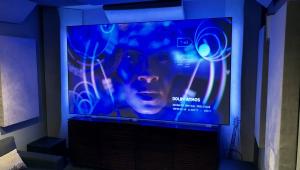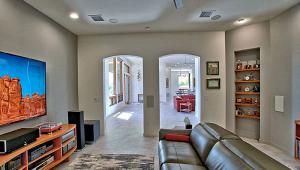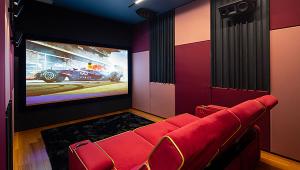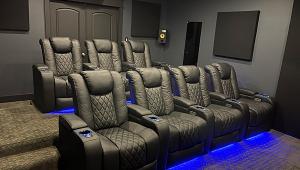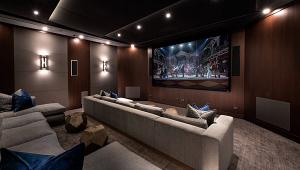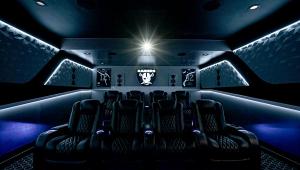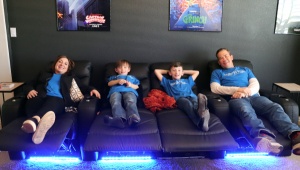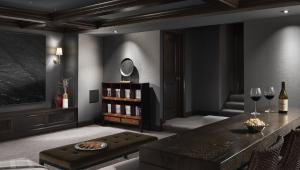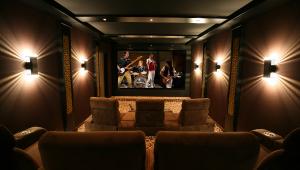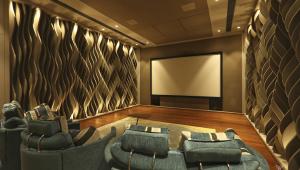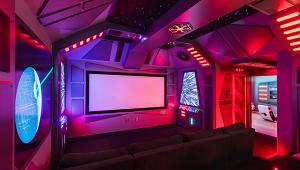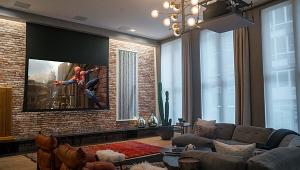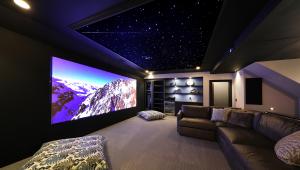The Great Outdoors

This year, Chris Parker, a principal in Chris Parker Custom Builders, decided it was his turn to add an outrageous appurtenance to the home he was constructing in the Legends Run development off the sinuous and verdant Hillsboro Pike artery that runs between Nashville and Birmingham. "I wanted something sexy but useful on a day-to-day basis," says Parker. "I had once seen a friend put up a sheet in his backyard to watch a Monday Night Football game. It was a blast being outside on a nice evening with a grill going and lots of friends around. I thought, 'What a great place to put a home theater—right outside your home!' "
He decided right off the bat to go with an alfresco cinema. But he also realized that mixing technology and home building was not necessarily his forte, so he called on Steven Hooper, owner of Audio Video Design Consultants in Nashville, to help execute a practical design.

Hooper relished the prospect of the project. To stay within budget, he decided to use Polk Audio and Yamaha sound components and a Screen Innovations screen. Due to the uncontrollable aspects of an outdoor environment, he knew installation would be the key to a successful outcome. "The biggest hurdle is locating two crucial components: the screen and the projector," Hooper explains. "Both have to be safe and dry, but both have to be out in the elements to make the outdoor system work."
Hot Stuff
A major issue in any outdoor technology installation is the effect of heat, moisture, and humidity. Franklin, just south of Nashville, sits in the Tennessee Valley, a bowl that literally sweats at the height of summer, where it doesn't need to actually rain to get wet. With this installation, the screen is most vulnerable. Hooper considered a few screen possibilities. At first, he specified an 119-inch PVC-based screen but, just prior to installation, changed to a Screen Innovations TM-119. The switch was based on several crucial points: PVC screens require tap tensioning to minimize screen bowing, while fiberglass screens are inherently more rigid. Hooper considered this important given the exposure to wind on the patio. Secondly, the warranty on the PVC screen would have been voided if it were used in an outdoor application. Scott Black, vice president at Screen Innovations in Austin, Texas, says the company's one-year parts-and-labor warranty will remain valid outdoors. Finally, Hooper cites the TM-119's slightly higher video gain, important in an installation in which nature has more control over ambient lighting than the theater owner.

The screen is positioned in a soffit above three oversized windows that illuminate the home's kitchen. In the soffit, two-by-fours tied into the second-floor joists create a truss from which Hooper could hang the screen and motor using threaded bolts. This is how you would hang the combination in a conventional theater, he says. Moisture is kept at bay by a combination of a tight screen wind and a cover over the soffit. The cover is made from the same type of wood that is used for the shake shingles that trim parts of the house. The screen fits through a slit in the cover panel.
The window placements were not random and are evidence of how helpful it is to have the outdoor theater design as part of the overall architectural plan: The windows are recessed, with brick borders that are flush with the soffit to help prevent wind from getting behind the screen and flapping it.

Hooper chose the InFocus 5700 projector because of its good long-throw performance—in this case, it's nearly 20 feet to the screen—and its low profile. Both are important: The plan called for the projector to hang on a Peerless mounting bracket from a wood panel in a compact enclosure in an 8-foot-high, stand-alone natural-gas-fueled fireplace. The fireplace is located on the opposite side of the patio from the kitchen windows. The enclosure has a swinging door, ornamented to match the patio's accents, that seals out the elements when it's not in use. The projector's cubbyhole is, of course, located away from the heat center of the fireplace. The team programmed the system's moving parts—the screen and the projector-housing door—as a macro to a single button on a Philips Pronto remote control. As an added precaution, they installed a moisture-alert device—the same type used in home-security systems to sound an alert in the event of water leaks—into the remote-control system. The device will automatically roll up the screen, close the projector enclosure door, and shut the system off in the event of rain while the system is unattended.
The remote control is an RF type. "I would have gone with infrared for an indoor installation, but sunlight interferes with IR operation," Hooper explains. Sixteen-gauge ProConnect wires run through PVC conduits that the builder and installer embedded into the patio prior to pouring concrete. They set the system's electronic components, including a Denon 1920 DVD player and a Denon AVR-3805 receiver, on shelving in a small, shallow closet just inside the patio door. The location was purposeful: It keeps home runs from components to the projector and screen motor as short as possible—in this case, less than 25 feet.
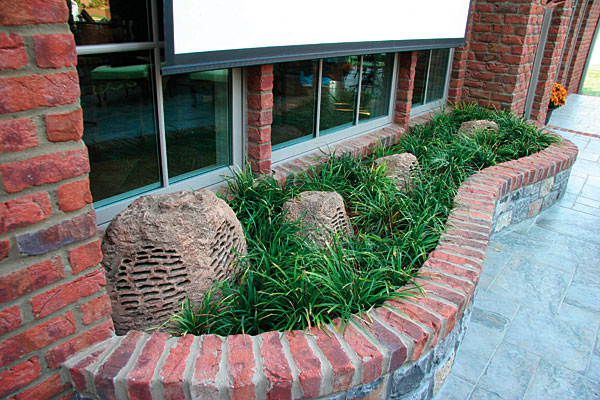
Sound & Lights
The outdoor theater is designed for 5.1 surround sound. Hooper chose StereoStone faux-rock speakers. The LCR array and subwoofer are in a planter in front of the kitchen windows, and two Polk surround speakers are in planters at the rear edge of the patio.
Low-frequency response outdoors is the biggest challenge for audio, says Hooper—there is little resonant area available (such as walls or a ceiling) with which the sub can interact. Midrange and high frequencies, however, will come across as good as the speakers allow. "We don't need bass traps in this installation," Hooper deadpans. "But we know that there's a limit to how much control you have to exert over the sound when you're outdoors." The power amps are 110 watts per channel. They may need all of it—the constant din of crickets characterizes summer nights in Tennessee.
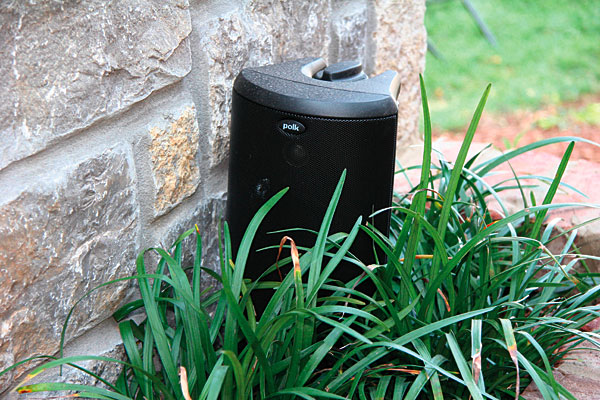
The outdoor lighting is a $5,000 package done by Outdoor Lighting Perspectives. Viewers will sit in well-heeled patio furniture or on built-in wood benches along the perimeter of the patio. "We had to keep in mind that this was going to be a conventional patio most the time, so we needed to keep it flexible," Hooper explains.
Celestial lighting, open-air acoustics, the occasional possum waddling by—these are the trade-offs implicit in an outdoor home theater. It's not going to have the same critical performance aspects that are expected of an indoor theater. But, says Hooper, "The compensation is the vibe. You're outside on a summer night, watching baseball on a big screen; the grill is going. Once you adjust your expectations, you're going to have a good time."
How It Works for You
- Consider Your Environment. What sort of weather do you have? Are you in California, with its temperate nights and sparse rainfall? The high altitudes of Aspen where traditional flat-panel displays could suffer? Your climate will definitely have an impact on the type of equipment you buy.
- Don't Pass on Bass. Good outdoor bass is hard to come by, so opt for a powerful subwoofer.
- Skip the Infrared Remote. Sunlight interferes with the commands on an IR remote, which will make operation temperamental. Use RF.
- Log in or register to post comments
